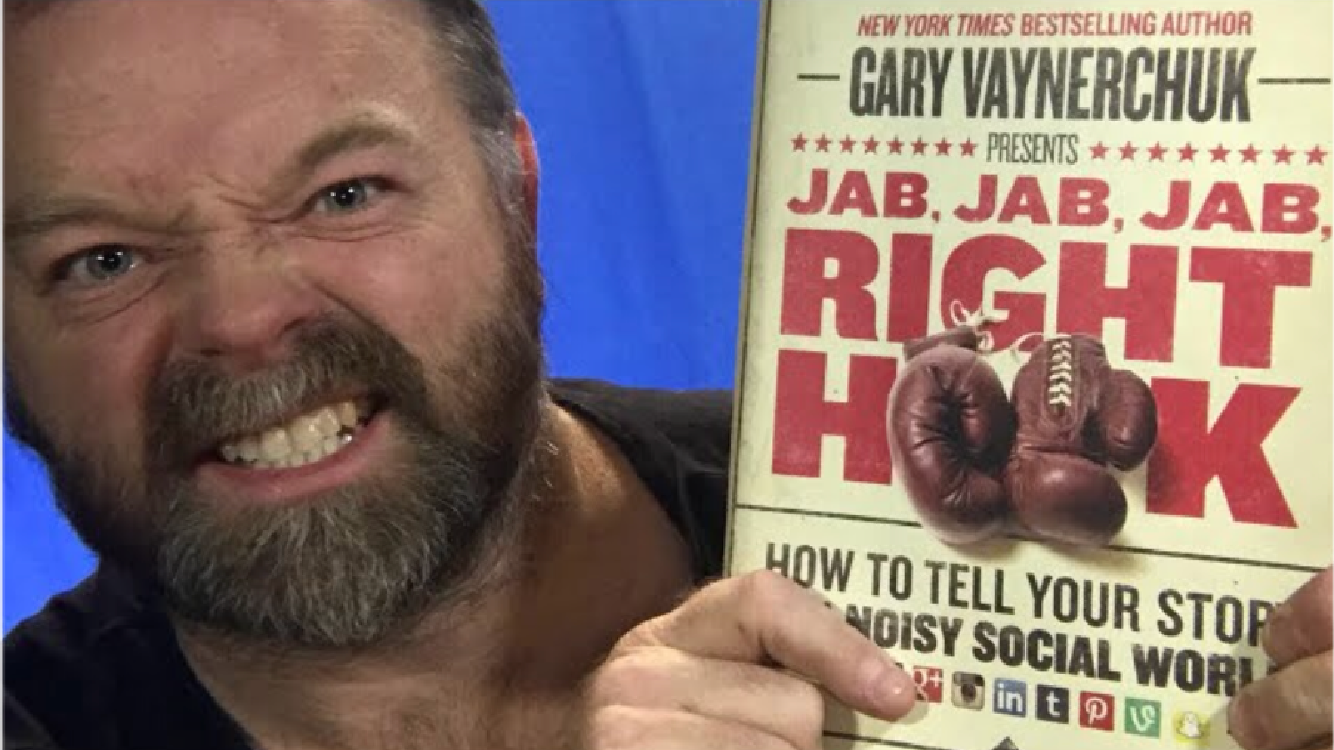Jab, Jab, Jab, Right Hook.
Written by Gary Vaynerchuk
This book, as Gary says on the cover, is a bit of a guide on how to tell your story in a noisy social world. This book was first released in 2013, and because of that and the changes in social media that constantly happen, you might think that it is no longer valid. Well, I want to counter that and say that it is just as valid today for the most part, as it was the day that it was written.
If you don’t know who Gary Vaynerchuk is, also known on social media as Gary Vee, he hosts a daily vlog called the Daily Vee. He has a guy (DRock) who follows him around every day and cuts together a daily vlog of what he does in his business world every day. He does that as a means to expose what the life of a real top level entrepreneur really looks like.
A Bit About Gary:
Gary’s parents moved from Belarus to the US when Gary was three years old. He says that when he was a child, six, seven years old, he had lemonade stands and he actually had six lemonade stands on the corners and he convinced his friends to man those lemonade stands while he was out looking at the streets, watching drivers as they pass by, working out where the drivers of cars we’re looking so he could see which pole or which tree was going to be the best place to put his sign.
In his early teens he fell in love with baseball cards and was trading baseball cards on the weekend, making two or $3,000 in a weekend. But his father started in a liquor store as a shop guy. He worked hard, long hours, spent very little money on anything that they didn’t actually require and put a lot of money away. Eventually bought his own liquor store.
When Gary was 14 years old his father dragged him into work in the liquor store and for the next two years, Gary was bagging ice for two bucks an hour every weekend down in the basement of the store and hated every minute of it because he went from earning two or $3,000 a weekend to $2 an hour.
Yep, that would have sucked.
When he got old enough, he was allowed to come up onto the shop floor and he very quickly realized that people collected wines which gave him an instant connection to that collective mindset because he collected baseball cards. He was a D & F student through high school. Essentially. This guy was not an academic. He is someone who is absolutely connected to the behavior and psychology of people and I think it’s something we as artists can relate to because it’s what we do when we create.
We’re tapping into, watching and understanding how people behave so that we can interpret that onstage or in music or through art.
So fast forward to when he was in college, someone came and grabbed him out of his bedroom and said, you’ve got to come and see this, and they went into another guy’s room in the dorm and they were looking at the Internet. Gary says they spent seven hours watching other people use the internet, and when he finally got to have a play he found himself fairly quickly in a forum where people were trading baseball cards. Having traded them physically on the weekends. He realized that he could now make a lot of money on the Internet.
Fast forward again, post college he has worked his way through the liquor store and is now running it. He is very focussed on selling and marketing and seems to have a good sense of what people will gravitate to. Within 3 months of YouTube being launched he starts a daily wine review show called Wine Library TV. He drank and reviewed the wines that they sold and that helped rocket their business.
He has moved and grown and now runs a multimillion dollar social media and marketing company called Vayner Media which now sits alongside a number of other companies he has acquired and banded together under the Vayner X brand.
If you have never consumed any of his content, I highly recommend that you get on YouTube and just start to understand the mindset that he applies to his business, to his life and the way he does things. It’s not going to be for everyone, he does get a bit sweary, but his understanding of human behaviour is excellent and he knows how the market flows.
BACK TO THE BOOK:
This book goes through every social media platform of note at the time that it was printed, so Twitter, Facebook, Google plus, Instagram, Linkedin, Pinterest, Snapchat and a couple of others.
Gary doesn’t just talk about how to post a photo on Instagram. In fact, it’s very little about the actual mechanics of the platforms. His recommendation and my recommendation, having followed his advice is to actually dig in and just start to play with the technology yourself, become a practitioner, have a go, post a few things in whatever platform it is, have a look around the platform and see how other people are using it. Then you know if it’s a platform for you or not.
He breaks down the mindset that most users are in when using each platform so you understand how to pitch your content at them. As an example he suggests a 40 year old woman looking at Pinterest is probably in a creative mindset, a purchasing mindset, window shopping, that kind of thing, and yet when on Facebook it’s more about connecting with family and friends.
What she is on that platform for is different, which means she is in a different method of thinking and needs to be approached in a different way through the content in order to connect with her. You could have the same image but your copy supporting that image will need to be worded a little differently to fit the tone for the each individual platform.
Digging down in to the understanding of the psychology behind the user makes this book as valuable today as its first day on the shelf.
The other thing he captures in each platform is the philosophy of the title. Jabbing in his terms is the giveing of free content of value to the user. The Right Hook is the Ask – would you like to buy my ‘INSERT YOUR PRODUCT HERE’. Note he says ask, not tell, not demand, not expect – ask. No expectation, because they may not be ready to buy yet. The consumer will buy when they are ready and to be able to grow a true relationship and connection for them to engage you need to Give Give Give, then Ask with out expectation.
Everything Gary preaches through his content and this book align with other key marketers of note that I have researched. the average customer, according to Dean Jackson, might take up to 3 months to purchase and some up to 2 years. So when Gary sprooks patience, you can understand why it is so important.
I found this to be an amazingly useful book and continue to find it incredibly useful as a reference guide.
FUTURE THINKING:
The platforms will change. Some platforms have come and gone and some will continue to do that, and we’re used to what we use as something new comes out. Gary suggests it will be the 9 to 14, 15, 16 year olds that are going to be the ones that become the early adopters of the new technology, the new platform, and they’re going to be the ones that you’re going to be trying to sell tickets to in five, 10 years after that.
To get ourselves into a mindset now where part of what we do with these platforms is not just work out how to use it, but we start to look at a mindset associated with that usage, will go a long way to improving the way that we engage with people on social media in regards to growing our profile, growing our business, selling tickets, building an audience through the application of some of this process.
Results:
In the last 12 months, I have applied the strategies suggested by Gary as best practice and having posted almost every day, focusing on what my target audience is after regarding content and I have managed to increase my Instagram following by more than double.
So I would say – he knows his stuff!
For all those reasons, particularly around the mindset and not just shaping my mindset for the ones that are in this book, but shaping my mindset for the ones the yet to come, I think has been truly beneficial.
So I totally recommend you grab this book.

